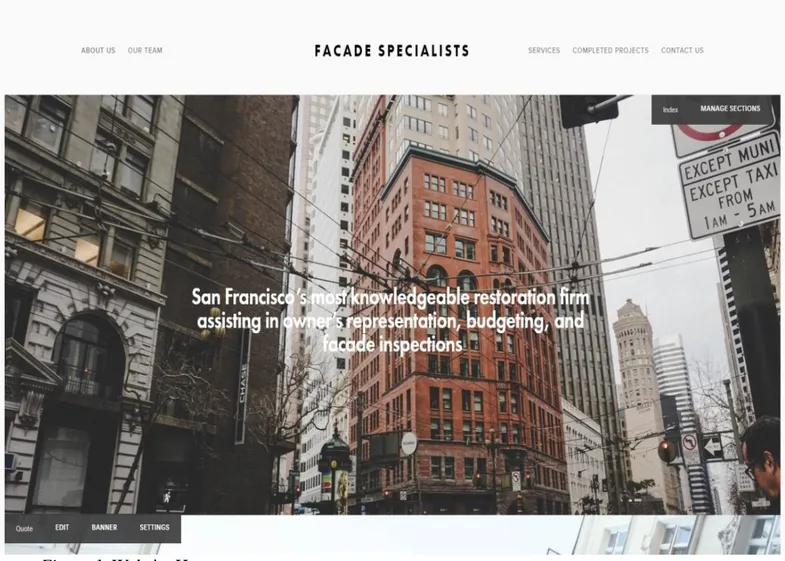Historic Building Renovation in San Francisco; A Business
Plan
Robert M. Courtney and Brendan Hoang
California Polytechnic State University San Luis Obispo, California
This report explores the history and thought process behind an idea for a historical restoration company based out of San Francisco, California. This is a vital service for both building owners and the public, as historical buildings with deferred maintenance pose a threat to the lives and safety of civilians in the streets below. The city of San Francisco recognized that historical buildings may pose a threat to public safety and recently put an ordinance in place to mandate inspections and repairs of these buildings. There seems to be a gap between firms that profess the ability to assign qualified individuals to perform façade inspections and the actual result that comes from these inspections. A highly experienced team has been put together to run this business, and this report covers the logistics of how this business will operate. Based upon industry leaders’ opinions in the niche, the author’s own experience in the niche, as well as financial data reviewed by a finance major, this plan seems to be viable for a historical restoration business offering consulting and construction management services.
Key Words: Historical Restoration, Façade, Business Plan, Finance, Construction, Consulting
Introduction
This senior project and business plan were developed as an idea over the past six years. I had worked with my dad over summer break every year since my Sophomore year of high school, and through my own experience and many conversations, we recognized a problem that could be solved through a unique business. The business area is historical façade restoration which only has a few competitors, and the competitors are relatively old school in the way they utilize construction’s current technological resources. After attending many OAC meetings with
designers from the perspective of the restoration contractor, a pattern appeared where money was being wasted. We plan to offer services in consultation, construction management, and budgeting & repair over a building’s life cycle.
inspection during a scaffold walk of a building. These new hires who are still gaining experience and often make mistakes are sitting in on OAC meetings, all the while having their hours billed to the building owner. Many building owners are aware of this, and when there has been correspondence between the restoration firm and the owners, owners have expressed their concerns. After multiple discussions with my dad, we came up with the idea for a restoration firm that would solve these issues.
If there was a restoration firm that could market and appeal to owners as being the authority on historical façade restoration, we could build trust within the SF building owner and building manager community. We would be able to bypass these architectural firms that are less
specialized in this area, offering more value and saving owners money. The knowledge comes from my father and one of his coworkers, who have been carrying out façade inspections and coming up with restoration solutions for around 40 years. The other requirement for this business would be a licensed architect or engineer to carry out these inspections. Ironically, the licensed architects that are required to carry out these inspections are often the people who make mistakes due to lack of experience and miss huge façade issues that are crucial to recognize. With industry experience backing this company, we would be able to hire a licensed engineer to sign off on inspections while utilizing the extensive knowledge of our co-founders.
In addition to the inspection services we would offer, there is potential for us to offer a
construction management service for the owner. In this scenario, we would oversee a contractor and report job progress to the owner. This service would be offered after we complete a
comprehensive inspection and tell the owner what needs to be done. This scope of business would likely produce success because the building owner will hopefully gain our trust after we present them with a comprehensive and complete plan of what needs to be fixed on their
building. This business will not step into the space of completing the actual work, rather we will identify and create a clear plan for the building owner to get certain repairs and maintain their building.
This business is also driven by a new ordinance in San Francisco, which mandates façade inspections on buildings built throughout the 1900s. This industry is already lucrative in San Francisco due to the plethora of old buildings. The façade ordinance means that building owners will be legally required to maintain their buildings, and this should increase demand for
restoration contractors even more. With the low amount of specialized building restoration contractors and this recently established ordinance, we believe there will be plenty of work to be done on these buildings
Competition Analysis
on whether a business will thrive. Many of the firms we will be competing against (roughly 5-10) are larger architectural firms, and while these firms offer a variety of services, myself and others who have worked in this industry have identified a weak point in their historical
restoration expertise. Individuals within these companies are no doubt very knowledgeable about historical restoration, however, there seems to be higher demand than supply for these
individuals, and people who may not have the required expertise are assigned to jobs they cannot handle. There are a couple of other big players in the restoration contracting space that offer similar services to the ones we want to provide, and we plan to offer better service through catering to the customer as much as possible with expert industry knowledge. We will also market our inspection and construction management services to a higher degree than our competitors. We want to target building owners and immediately get their respect and trust, allowing us to carry out thorough inspections on their buildings and even offer CM services to manage their buildings while they are under construction.
Interdisciplinary Aspect
When hearing about the potential for this project to be interdisciplinary, I immediately thought that a finance major would add a nice aspect to the entrepreneurial element. Brendan Huong, one of my good friends and a finance major, has the entrepreneurial drive I share. He has completed work at his summer internship for clients such as Wells Fargo and is well versed in the financial makeup of companies. The financial data in our Profit & Loss statement as well as the necessary starting costs for the business have been talked through in detail between me and Brendan, and we have reached numbers that we are confident in to be a realistic outcome. With the creation of a business, accurate financial planning is vital to success and mishaps can result in a business failing. We have run through staffing plans and expenses, and have come up with something that is scalable long term while having the potential to handle a fair amount of work initially
Steps taken to deliver the project
Since forming this idea into an actual senior project, I have taken various steps to bring this idea to life. Firstly, I went through the financial aspect of the business with Brendan. I had looked at staffing plans and the general business procedures the restoration contractor I worked for over the past summer had used, and this information helped to create a plan. A website called live plan was used to forecast financial data and come up with initial staffing numbers. In addition to this, I have been in close contact with my cousin who is a licensed engineer and who has
Deliverables
The most important deliverable that was worked through is the Profit and Loss Statement (Figure 4) as it determines if the business is viable. This deliverable considers our projected revenue as well as what our expected expenses are. The details of this statement are found under Figure 4. Due to the business being based in consulting, there are not a lot of funds required to get it running. After the business has its infrastructure established, we plan to get customers through online marketing. Online advertisements are very powerful and not many construction
companies are currently utilizing them effectively. Advertising through Google and Facebook ads allows for specialized targeting of different groups, and due to this restoration business being very niche, customers most likely to be interested in our service can be targeted. More
specifically with the advertisements, we have identified our primary customers as members of the Building Owners and Management Association (BOMA). This group will be targetable through online ad campaigns to bring prospective customers to our website. A robust and
While there is not yet a defined name for the company, a website was created to serve as a template for the future of the business. Squarespace was utilized as the platform to build out a complete and modern looking website.
Figure 2:Website Homepage, Description of Services
The website’s homepage has a scroll feature that allows you to learn more about the business as you scroll down through multiple pages. This section of the site shows our services of owner’s representation, façade inspection, and budgeting and maintenance.
Figure 3:An overview of the Profit and Loss Statement
2021 (or the first year of business) and then increase to a somewhat stagnant level for the following two years.
Figure 4:The Profit and Loss Statement
The revenue in this profit and loss will come from billable hours for our senior consultants, junior consultants, and hired architect. We plan to charge at a rate of $275 per hour for senior consultants, $150 per hour for junior consultants, and then $360 per hour for the architect. We project that an architect will charge us $300 per hour for their inspection and sign off, and the $360 per hour figure comes from marking that up 20% billed to the owner. The bulk of the revenue will be from our consultation staff, meaning that an architect would only be hired for around 30 hours or less per week.
The direct costs in this statement come from our payable wages to employees. We are paying our employees roughly 55% of the earned revenue, allowing us to have built up savings and
potentially invest in more employees if demand requires. How much employees are paid, however, will greatly fluctuate depending on demand in the market.
Operating expenses in this profit and loss are relatively minimal compared to revenue. Our main expense will be our office rent. This will be $2500 per month for a space to hold 5-10 employees year-round in San Francisco. Another expense that will potentially increase is our Facebook ad campaign. We will run ads targeting the Building Owners and Managers Association (BOMA) to hopefully land 5-10 initial clients. If this goes well, we can increase our spending on ads to reach as many potential clients as possible.
One of the biggest lessons learned during this project is how forecasting the financial data into the future is very difficult to do if the company is not already operating. The people I have talked to in the industry about this agree that it is very niche and solves an important problem, however, it is very hard to say if the company will meet financial projections or fall flat. Due to the niche of the industry and the fact that not many people are involved in this specific area, we believe that this company has promise for success, but it is hard to determine before the company is operating.
Another powerful lesson that comes with this project is the power of online advertising through social media and Google. When running through potential ad campaigns and target groups, we found that we can directly target customers in the Building Owners and Management


